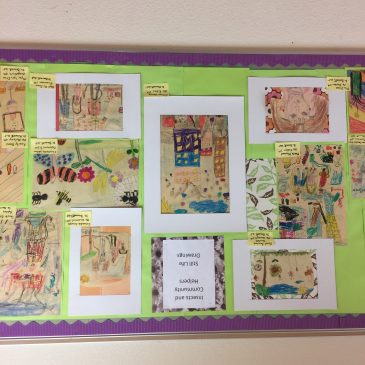The arts help students learn because they offer a natural learning pathway from thinking to doing. When we use drawing to give life to history, or poetry and drama to give life to English, or painting to color in histograms, we naturally use art to involve every student in academics. There are no wrong answers when using the arts and students intuitively know this so they jump into the work, naturally.
Traditional forms of education, where one teacher talks and many students listen provide little room for students to express their ideas. The Socratic method, where students are asked for their opinion can be a great follow up to traditional teaching. More progressive forms of teaching, where traditional teaching gives way to student-centered learning creates real ownership of what they have learned.
The Project Method
Project learning that integrates the arts may be one of the most fruitful ways that the arts help students learn.
The project method is a medium of instruction which was introduced during the 18th century into the schools of architecture and engineering in Europe when graduating students had to apply the skills and knowledge they had learned in the course of their studies to problems they had to solve as practicians of their trade, for example, designing a monument, building a steam engine.[1] In the early 20th Century, William Heard Kilpatrick[2] expanded the project method into a philosophy of education. His device is child-centered and based in progressive education. Both approaches are used by teachers worldwide to this day.[3] Unlike traditional education, proponents of the project method attempt to allow the student to solve problems with as little teacher direction as possible. The teacher is seen more as a facilitator than a deliver of knowledge and information.
—THE PROJECT METHOD
The Elusive Role of Integrating the Arts
When thinking about facilitating learning, actively integrating the arts into the courses and the lives of their students may prove beneficial. However, integrating the arts and recognizing the specificity needed to understand what integrating the arts means has proven to be elusive. Many educators disagree with integrating the arts because it makes the arts subservient to other domains and they prefer to think of the best use of the arts as “art for art’s sake.” Deepening the elusiveness of arts integration in classrooms is that educators think they are integrating the arts when they have their students sing a song in class. And to some extent, singing the alphabet song to remember the order of the letters from A to Z is an arts integration example although it is a very standardized use of integration.
Project Based Arts Integration
A leading edge use of the arts in education looks like teaching artists working with teachers to build project-like curriculums where the use of the arts are fully overlapped, integrated, and assessed. The artistic skill-sets are woven into the learning of the educational domains such as English Language Arts, Math, Science, Social Studies, Engineering, Technology, etc., but those skill-sets are not used to rate student artistic success alone. Both domains—e.g. drama and English, painting and math, or singing and engineering—are equally assessed. The project-based curriculum of integrating the arts should result in assessments that show that the arts enhanced the engagement in the domain, the arts solidified the remembrance of what was learned, and the arts helped every student participate and take ownership of their learning.
Equity and Access
The United States has an unequal educational system. The reasons for this are complicated and not easily teased out, but the persistence of poverty in our schools prevents our students from receiving access to the best education they deserve.
A growing share of children from low-income families attend school in districts where poverty is concentrated, creating huge educational challenges. In most major U.S. cities, for example, a majority of African American and Latino students attend public schools where at least 75% of students are from low-income families. Increasingly, these schools are segregated by both race and class. For example, in Chicago and New York City, more than 95% of both Black and Latino students attend majority-poverty schools, most of which are also majority-minority.
—LEARNING POLICY INSTITUTE
The Arts Help Disadvantaged Students Learn
One of the best outcomes from my research has been the benefit that the arts convey to students who are at risk for poverty, language, and achievement. The arts help these students to be creative because they offer a natural pathway to realize learning success. For example, when a teacher directs the students to paint their thoughts, there is no wrong answer, the students realize that, and they start to produce! The arts give disadvantaged students an equitable footing in class and that builds ownership, intentionality, and a drive to succeed. The arts naturally help all students learn, especially our most vulnerable ones.




